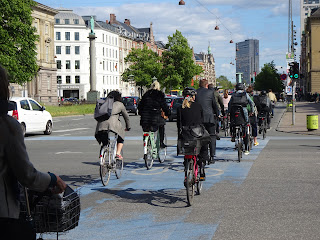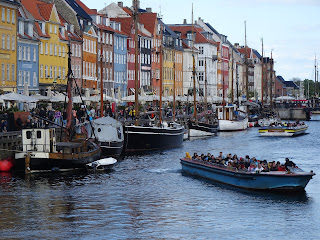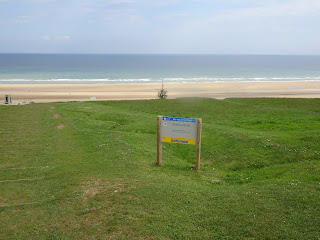Copenhagen seems to be a friendly city where everyone gets along and does their part. The people living and working here come from all over. But instead of separating into different communities, they work together and aspire to a similar lifestyle. Of course, my sample size of people met is small but we get this sense of shared values in all encounters. Newcomers are learning Danish and English in order to fit in. We have been here before and walked the central city; on this trip we plan to visit two of the outlying attractions
Interesting building in central Copenhagen.
Arriving at CPH airport, we took the regional train to our hotel in the Kodbyen area. Nearby are many good restaurants; good seafood, but many options are available. You see very little obesity here; people walk or ride bikes to many destinations. Dawn and I rented bicycles today and pedaled to the fishing village of Dragor. I was imagining riding along secluded country lanes to get there; but that was not how it worked out. Instead, we were navigating through Copenhagen suburbs (a canal, train tracks, highways, construction zones) and around the edge of the airport. Without the program 'maps.me' we would not have made it.
The pretty fishing village of Dragor. Almost all buildings had yellow-colored wall with either tile roofs or a thatched roof, some of which are still being newly installed. Cobblestone streets. Spring, with the smell of lilacs and newly mowed grass, is in the air. Temperatures still mainly in the 50's.
We ate lunch at an outdoor cafe overlooking the harbor.
Bicycling in Denmark is serious business. We were given a short summary of bike traffic rules before heading out, and we needed them. Coming back this afternoon, we started to encounter bicycle rush hour. It was also walking rush hour, and driving rush hour. These people ride bikes daily and keep a fast pace. Try not to get embarrassed when a woman with her shopping basket or baby on board passes you by. I do enjoy the challenge of finding the route from lines on my I-Pad screen.
Interesting building in central Copenhagen.
Arriving at CPH airport, we took the regional train to our hotel in the Kodbyen area. Nearby are many good restaurants; good seafood, but many options are available. You see very little obesity here; people walk or ride bikes to many destinations. Dawn and I rented bicycles today and pedaled to the fishing village of Dragor. I was imagining riding along secluded country lanes to get there; but that was not how it worked out. Instead, we were navigating through Copenhagen suburbs (a canal, train tracks, highways, construction zones) and around the edge of the airport. Without the program 'maps.me' we would not have made it.
The pretty fishing village of Dragor. Almost all buildings had yellow-colored wall with either tile roofs or a thatched roof, some of which are still being newly installed. Cobblestone streets. Spring, with the smell of lilacs and newly mowed grass, is in the air. Temperatures still mainly in the 50's.
We ate lunch at an outdoor cafe overlooking the harbor.
Bicycling in Denmark is serious business. We were given a short summary of bike traffic rules before heading out, and we needed them. Coming back this afternoon, we started to encounter bicycle rush hour. It was also walking rush hour, and driving rush hour. These people ride bikes daily and keep a fast pace. Try not to get embarrassed when a woman with her shopping basket or baby on board passes you by. I do enjoy the challenge of finding the route from lines on my I-Pad screen.
When bicycling, do not get in the pedestrian lane or the vehicle lane. Ride on the right side of the street. If you want to turn left at an intersection, you proceed straight across the intersection, then stop your bicycle and wait for the signal to change before actually turning left unto your new street.
We took a train to Roskilde today. A nice town with a big cathedral and pedestrian shopping area, but most notably, a Viking ship museum where new Viking ships are being built in a traditional manner. Lots of history presented and you can even take a cruise of the bay in one of their authentic vessels. You can walk from the train station to the Viking Museum. First walk to the cathedral (look for the tall steeple) then continue in the same direction down the hill, past a park, until you reach the bay.
The Roskilde church is a UNESCO site as one of the earliest brick cathedrals. A nice pedestrian shopping area is nearby.
The Viking ship museum and building site is very popular. They were constantly taking people out in these boats, even raising their square sails when the wind was favorable.
Five Viking ships, almost 1000 years old, were carefully excavated from the bay and are now housed in a climate-controlled building. Roskilde was once the most prominent town in Denmark.
At the workshop, they build replica Viking ships using the same materials, techniques and tools as originally used. The largest present is about 100 feet long and has been sailed to Ireland and back.
I loved this boat building demonstration. I am building a similar style 15' boat at home. It was interesting to see that they use a similar sequence in fabricating the parts as I do. I picked up some ideas that may be useful when planking/sheathing the hull begins.
Copenhagen is a city of canals. Hans Christian Andersen had a home on this street.
We had been here previously and had seen the attractions of the central city: the Little Mermaid, Tivoli Park, etc., but with sundown not until almost 10pm at this season, upon returning to the city in late afternoon, we did retrace a walking route through the city itself. Copenhagen has extensive pedestrian-only street connections, plus many canals and regular streets. You will always find a bike lane.





















































